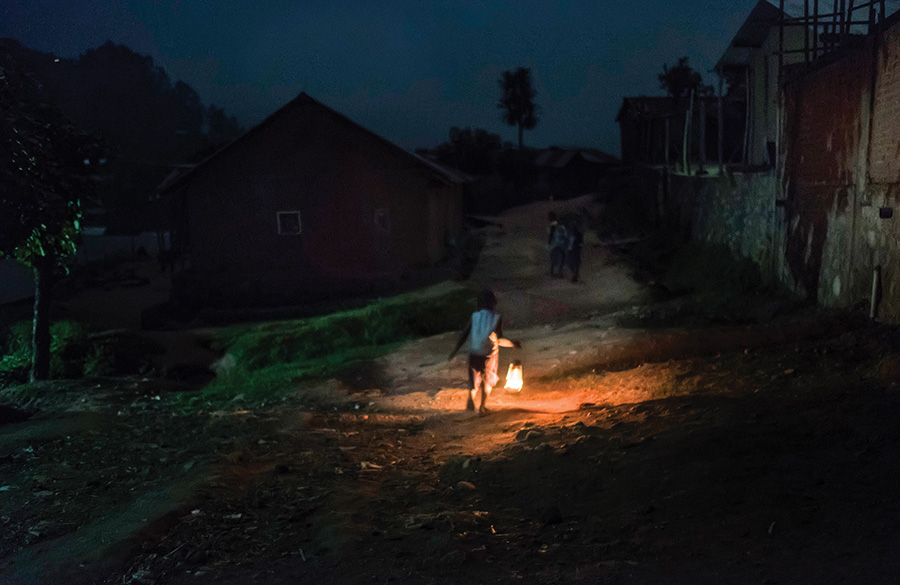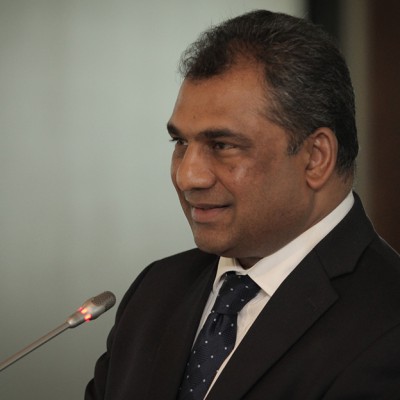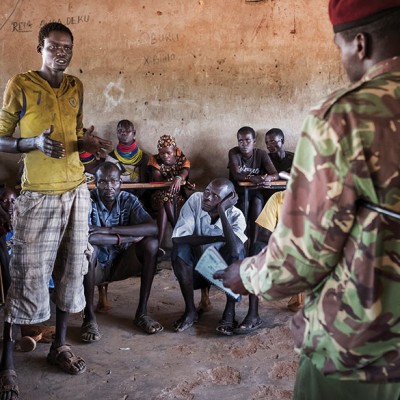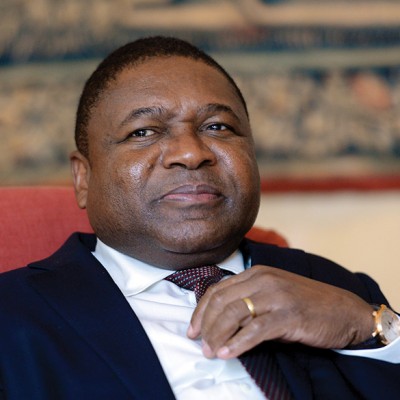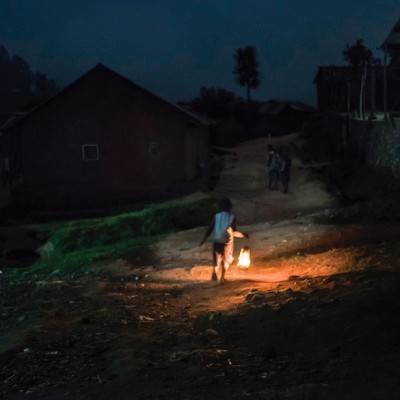Introduction
In the eastern Democratic Republic of the Congo (DRC), rural electrification is being proffered by the oldest national park on the continent as a pathway for economic development and conflict reduction. The 400 kW Mutsora hydroelectric facility, located in Mutwanga village in eastern Beni territory, North Kivu province, provides power to approximately 450 homes and businesses. The project is implemented by Virunga National Park (VNP) and the broader public-private sector Virunga Alliance, which together are targeting investments in hydroelectric power, microfinance, fisheries, tourism and agricultural transformation industries. The Mutsora hydroelectric facility is one of two completed facilities in North Kivu – the other being a 13.2 MW hydroelectric facility in Rutshuru territory. Construction on a third hydroelectric facility – of 11.6 MW in Lubero territory – was underway as of July 2016.

Hydroelectric power is generated by using moving water to turn one or more turbines. The Mutsora hydroelectric facility – as with all facilities planned and implemented by VNP and partners – is a “run-of-the-river” facility, where no dam or reservoir is created. A portion of the river’s flow is diverted into a canal, run downhill to the turbines and then returned to the riverbed downstream. These kinds of facilities are cited as having less environmental impact than a dam- and reservoir-based electrical generation system.1
The basic theory of change relating to these hydroelectric development projects is that electricity provision can lead to a suite of job and income-generation opportunities previously unavailable; increased employment can lead to both improvements in household and community well-being, as well as decreased participation in armed groups; and greater civilian well-being and fewer armed group combatants reduce particular pressures on the park, leading to improved conservation outcomes. This article addresses the first linkage in this theory of change – that the availability of electricity can lead to job creation – and explores other contributions (community and household well-being) through the Mutsora hydrofacility case study.
This article offers a conceptual background that discusses the context for this case study in the eastern DRC; the research methods utilised during our data collection; study results and discussion in terms of socio-economic outcomes for service institutions, households, small businesses and the agricultural transformation industry; and our conclusions.
Conceptual Background
Protracted conflict in the eastern DRC has long been fuelled by poor governance, ethnic tensions, land conflict, poverty, competing international interests and corrupt power relationships. For VNP, a World Heritage Site and one of the most ecologically rich, protected areas in the world, these regional dynamics present particular challenges. There are intense local and international demands for resources in the park, rebel groups that confront VNP rangers and take refuge inside the park, and local communities which see VNP as partly responsible for their social protection and economic advancement.
For decades, the DRC government has failed to provide either basic services or an enabling environment for economic opportunity to the majority of its citizens, and it has failed to prioritise good governance over corrupt self-interests that directly facilitate ongoing conflict. Non-governmental and other international organisations have stepped in to equip and staff area hospitals, build schools and public water access, develop agricultural extension programmes and manage population displacement during conflict, among other services. VNP – itself managed by DRC’s national parks’ authority, the Institut Congolais pour la Conservation de la Nature (ICCN) – is emerging as a regional leader by engaging in the implementation of community development projects in North Kivu, and providing an example of a way forward for other government entities in the DRC. Investment in infrastructure – in particular, renewable energy infrastructure – as community development is a new approach for a national park anywhere; it is even more novel for a park located directly in a region plagued by violent conflict, in one of the poorest countries in the world.
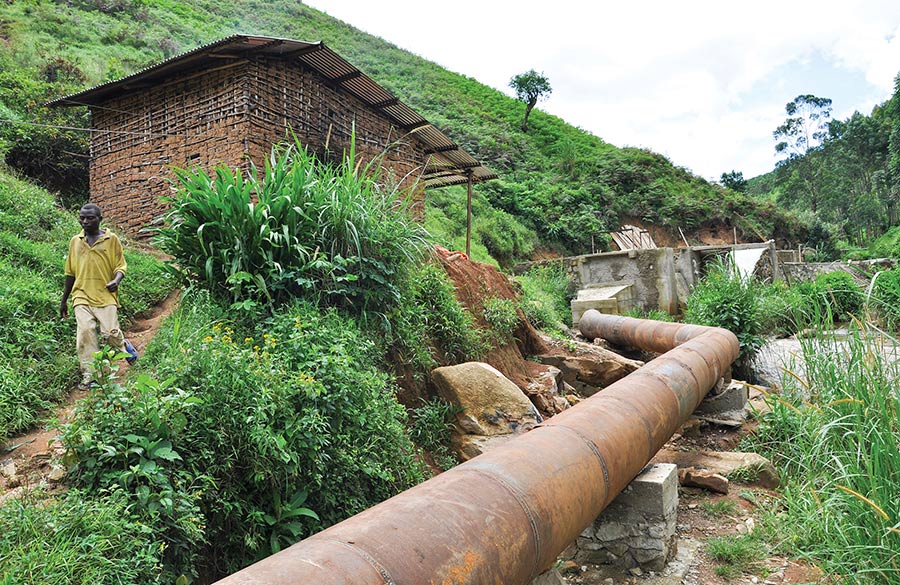
Mutwanga village is located in eastern Beni territory in North Kivu province, about 40 kilometres by road from the Kasindi border crossing into Uganda. The village sits at the base of the western slopes of the Rwenzori Mountains and just outside the border of VNP. The Mutsora run-of-the-river mini hydroelectric facility is located just outside the park near the VNP ranger station, and electricity distribution reaches a service area of about 4250 households.2 Historically, the community has had several small-scale hydroelectric projects, but the service area and capacity of these projects has been extremely limited. While there is some household and business electricity connectivity via public and private generators, the vast majority of the population has not had access to electricity.
Construction on the Mutsora hydroelectric facility began in October 2010 and electricity distribution started in November 2013. Connections to the grid steadily increased until October 2015, when the facility reached its capacity at 530 connections. Since then, new connections have not been accepted.
The impacts of sustainable energy development and rural electrification are often recognised as beneficial to both poverty reduction and environmental conservation.3 Early studies of rural electrification in developing countries showed gains in agricultural productivity due to electricity-utilising technology both directly (water pumps, mills and lighting for dairy and poultry4) and indirectly (cold chains for high-value goods, repair shops for tractors5). Micro-enterprises and household cottage industries often are able to increase their productivity with electric tools (carpentry, welding and sewing machines) and bright lighting to work longer hours into the evenings.6

Despite these gains, some studies note that rural electrification alone does not bring about vibrant social and economic growth;7 in fact, it has been shown that grid-based rural electrification often benefits the wealthier members of a community, rather than the poor.8 Studies of electrification as part of a set of development initiatives demonstrate that policies and a plurality of approaches matter. Examples of these initiatives include structural interventions that address job creation, gender equality, agricultural production and markets, health outcomes associated with cooking fuels, and educational attainment.9 The interconnected nature of these different aspects of socio-economic life are crucial to understanding the next step in the project’s theory of change: that economic development will lead to a reduction in rebel group recruitment and violent activity. This next step has scant empirical evidence in the eastern DRC, and follow-up research and analysis are needed to delve deeper into the issue.
Research Methods
To explore the dynamics and impacts of hydroelectrification in the Rwenzori sector of Beni territory, we developed a mixed-methods approach utilising randomised stratified sample household surveys, key informant interviews, stakeholder focus groups and business surveys. A baseline study (March 2015) and a follow-up study (October 2015) were conducted using this approach. We hypothesised four primary avenues of socio-economic impact for this rural electrification project: public institutions and services, household well-being, small business connections and agricultural transformation industry.

For our household sampling strategy, we worked within the local administrative structure (which encompasses, in decreasing size order: territories, sectors, groupements, localités, quartiers/villages and dix maisons) to identify a sample frame, comprising localités served by the Mutsora facility and all localités with boundaries with that localité. For the baseline survey, we collected information about the number of dix maisons in each quartier/village in the sampling area. For the quartier/village in the area currently served by the hydroelectric facility, a structured sampling method was used whereby three dix maisons were chosen from each quartier/village: the nearest to the road, the farthest from the road, and one in the middle at the furthest extent of the power lines. Then a fully randomised sample of dix maisons was surveyed from the surrounding localités, stratified at the localité and village level. This resulted in a sample size of 405 households from villages within the Mutwanga grid’s service area (the treatment area) and 505 households from the surrounding (unserved) area (the control area). In total, 58 (or 15%) of the 393 grid-connected households were surveyed. For the quarterly follow-up, a total of 32 dix maisons were surveyed – at 16 households per dix maison, this gave a sample of 500 households. Dix maisons were randomly selected: two-thirds from the original treatment group and one-third from the original control group.
Focus Groups and Interviews
We used focus group and key informant interviews to gather qualitative data. We sought diversity of opinion through discussions with various geographic, gender and sector-based focal groups. Specifically, we targeted local leadership, agricultural groups, “youth” (aged 18–25), businesspeople, women’s groups and social service providers (hospitals, schools) for information on members of communities who can and do access the hydroelectric grid and those who do not or cannot access the grid. We conducted 10 focus groups and 10 key informant interviews each for the baseline and follow-up. Focus groups were thematically coded and queried according to both emergent themes and research hypotheses.
Business Survey
Businesses were surveyed along four one-kilometre transects, including the primary commercial regions in Mutwanga and in three of the surrounding (non-electrified) localités, and in a one-kilometre radius around the Sicovir factory. Surveyors walked the length of the transects in pairs, one on each side of the street, making note of every business they passed according to the type of business, construction (whether permanent building location, kiosk or street vendor) and global positioning system (GPS) coordinates. Surveyors then surveyed every other business on each side of the street. A total of 490 businesses were documented, and 67 grid-connected and 192 non-grid-connected businesses were surveyed. We attempted to survey all 112 grid-connected businesses; however, 25 businesses were missed due to temporary closure, and the remaining 20 grid-connected businesses were permanently closed.s
Study Results and Discussion10
Public Institutions and Services
Eight public service institutions are connected to the Mutsora grid, including the regional hospital, radio station, orphanage, local government office, army station (Forces Armées de la République Démocratique du Congo – FARDC), two schools and the Mutsora (VNP) Ranger Station. The Mutsora hydrofacility provides approximately 15% of its distributed electricity for free to public and government institutions, including the schools and the police station. Electricity provisioned to the hospital comes at a fee, but the hospital is guaranteed first delivery of power, even if the stream flow is low in the dry season and power generation is limited. Having top priority for electricity distribution guarantees the hospital can maintain a cold chain for the blood bank and vaccines. It is also ensured light during surgeries, compared to earlier times when the generator might break down or run out of fuel and surgeons would have to use flashlights. The hospital charges each intake patient a surcharge to help pay for the electricity; however, this surcharge was lowered from US$3/intake (when they relied on a generator) to US$1/intake with Mutsora hydroelectricity. This is a significant difference for the local community, as daily wages for agricultural labour average US$1.87 for women and US$2.00 for men. Additional benefits at the community level include public lighting in the serviced communities, which is credited with increased security.

Household Well-being
The 418 grid-connected households at the time of this study constitute approximately 10% of the households in the service area. Connected households spend an average of US$4.51/month on electricity, which is equivalent to 21.5 kWh/month. Of all the households surveyed, 27% report having some source of off-farm employment, which is positively correlated with access to electricity, and with hydroelectric power in particular. Income earned specifically through the use of electricity is reported in 12.1% of households with hydroelectric power and only 1.6% of households without hydroelectric connection.
Households utilise electricity mainly for lighting, which provides their children with the opportunity to study and home-based professionals such as tailors to work longer hours or later in the evening. Households also use electricity for radios, charging cellphones, and televisions. Cottage industries are common, where households utilise their electricity connection to power tools or perform tasks for others – for example, informally charging others’ cellphones. No households in the service area reported cooking with electricity, despite knowledge and expressed interest in the technology. Provision of electricity as an alternative to charcoal cooking is a major goal for VNP, to reduce deforestation in the park. The average household (6 persons/household) around the park uses two 35 kg bags of charcoal in a month,11 which at the Mutwanga market price of 500 Congolese francs (Fc) for 3 kg equates to a monthly household expense of US$12.68 on charcoal. While the cost for charcoal is triple the average grid-connected household’s expense on electricity, generating the same amount of cooking heat using electricity could be much more expensive. In addition, reliance on electricity for cooking would necessitate a reliable power supply, which can be a serious issue given limited stream flow during the dry season.

Job Creation in Small and Micro-enterprises
Small and micro-enterprises (SMEs) are major players in the economies of sub-Saharan Africa. For example, SMEs generate 30% of Kenya’s gross domestic product (GDP) and over 90% of job creation outside agricultural production.12 In Mutwanga village during this study’s survey period, there were 504 businesses along the major thoroughfares where electricity was being distributed, half of which were surveyed during the study and 22% of which were connected to the Mutsora hydropower. The high demand for electricity by both pre-existing and start-up businesses helped to guarantee a client base ready to consume as much electricity as the Mutsora hydrofacility was able to produce. Of the businesses connected to the Mutsora grid, 35% are newly established because of the advent of hydroelectricity provision. Businesses save an average of US$106/month using Mutsora grid power instead of paying for generator fuel – almost enough to entirely recoup the US$100 connection fee in just one month – but outages in power during the dry season incentivise 30% of these grid-connected businesses to maintain their own back-up source of electricity.
There are six major employers in the service area with over 14 employees– including two religious schools, the radio station, a Fair Trade cocoa processor, the hospital (67 employees), and the Mutsora hydroelectric station itself (35 employees). We were able to document 248 employees in 67 active commercial and public enterprises connected to the network (not including the Sicovir soap factory, detailed later) – an average of 2.4 employees per grid-connected business. (We were not able to survey the remaining 45 grid-connected businesses during the fieldwork periods, so the true number employed will be higher, though the rate may be lower.) In non-grid-connected businesses, we documented 315 employees in 191 businesses – or 1.65 employees per business.
Women own and operate 10.4% of the businesses connected to the grid, and 12.9% of businesses that started because of the availability of electricity are owner-operated by women. Male employees outnumber female employees, regardless of connectivity. Of all businesses surveyed, there are 1.62 male employees for every female employee; businesses without electricity are more equitable, with 1.44 male employees per female employee; for hydro-connected businesses, the ratio is 2.04 males for every female employee; and for non-grid-connected businesses with an alternative electricity source, the ratio is 2.89 males for every female employee.

Agricultural Transformation Industry
The Sicovir soap factory is located at the edge of Mutwanga. Construction on the facility began in September 2013 and operations began in the spring of 2016. Sicovir will require 650 kVA when the soap factory is running at full capacity. It anticipates purchasing 250 kVA from the Mutsora hydroelectric facility and supplementing the rest of the electricity need with diesel generators.
Sicovir provides employment to the local community through short-term, low-skilled jobs and permanent skilled jobs. During construction periods for the facility, over 250 workers were employed at the site (including factory hires, contracted companies and temporary hires). At the current production level (January 2017), the factory employs 66 workers directly, in addition to 40 externally contracted workers on site. When the factory is operating at full production, it anticipates directly hiring an additional 100 new workers.
In addition to employment provision, the Sicovir factory purchases crude palm oil, palm kernels and palm kernel oil from local producers via local depots. It also purchases other agricultural goods – including wood, beans and rice – directly from local producers. The majority of the population in the Mutwanga area is supported primarily by agriculture, with 66% of households cultivating palm for sale,13 so there is significant potential for positive economic impacts across a broad population base through agricultural purchases. During production trials in the second quarter of 2016, for example, the factory purchased at least US$250 000 in local goods from producers and agricultural intermediaries.
Palm farmers in the Rwenzori sector would like to benefit from the direct sale of their products to Sicovir. By cutting out the intermediary agricultural depots and reducing their transportation costs, palm farmers believe they are likely to receive better prices and reduce their risk of suffering road accidents. However, Sicovir’s capacity to purchase directly from farmers is limited by the costs it would incur to drive from village to village picking up small quantities of oil – two or three 20-litre jugs per farmer – when the factory demands an average of 30 metric tonnes of palm oil per day for full production. Since a significant portion of the eventual village-level capital influx through agricultural purchases will come through palm oil purchases, the actual benefit to smallholders themselves remains to be seen.
Summary of Job Creation across all Grid-connected Businesses
In summary of the jobs created and jobs supported by businesses connected to the Mutsora hydroelectric grid, we calculated a ratio of “jobs per megawatt” of installed capacity. This calculation – if scalable – can help inform policy and planning for larger facilities being built in North Kivu. Employment in grid-connected small businesses totals a conservative 248 employees, and 56 of these employees are in businesses that were started because of the Mutsora hydrofacility. There are 35 employees directly employed by the hydrofacility. The Sicovir soap factory has had variable employment since breaking ground in September 2013 – at times, there were over 200 workers at once on the construction site – but in each month over the past four quarters, the facility has employed 56–66 permanent and temporary workers. This means that during the period of this study, a conservative employment calculation of employees in grid-connected businesses is between 310 and 339 workers per month. If this calculation is generalisable across scale, we calculate a monthly ratio of 886–969 jobs per megawatt of installed capacity supported by the hydroelectric facility. In addition, as the Sicovir soap factory was installed due to the development of the hydroelectric facility, at least 118–157 employees per month are directly attributed to the electrification. This job creation corresponds to a conservative ratio of 337–449 jobs per megawatt of installed capacity due directly to the establishment of the hydroelectric facility.
Conclusions
The Mutsora hydroelectric facility servicing Mutwanga village has impacted the community via four primary action pathways: public institutions and services, household well-being, small businesses and agricultural transformation industry. The challenging next steps for researchers and practitioners will be to show whether the impacts outlined above are scalable across larger hydroelectrification projects, whether or not this economic development can help reduce violent conflict and armed group participation in the region, and whether these sorts of projects ultimately benefit both conservation and local communities. While the pathways for economic development in rural communities – in particular, communities in conflict, such as those in the eastern DRC – are complex and challenging, the payoffs of rural electrification in this particular community case study show early signs of promise.
Endnotes
- Anderson, David, Moggridge, Helen, Warren, Philip and Shucksmith, James (2015) The Impacts of ‘Run-of-River’ Hydropower on the Physical and Ecological Condition of Rivers. Water and Environmental Journal, 29 (2), pp. 268–276.
- All data are findings from our study, unless otherwise noted.
- Cecelski, Elizabeth and Unit, A.A.E. (2000) Enabling Equitable Access to Rural Electrification: Current Thinking and Major Activities in Energy, Poverty and Gender. World Development Report, 1 (2-3), pp. 2–13.
- Barnes, Douglas F. and Binswager, Hans P. (1986) Impact of Rural Electrification and Infrastructure on Agricultural Changes, 1966-1980. Economic and Political Weekly, 21 (1), pp. 26–34.
- Kirubi, Charles, Jacobson, Arne, Jacobson, Daniel M. and Mills, Andrew (2008) Community-based Electric Micro-grids can Contribute to Rural Development: Evidence from Kenya. World Development, 37 (4), pp. 1208–1221.
- Ibid.
- Burlig, Fiona and Preonas, Louis (2016) ‘Out of the Darkness and into the Light? Development Effects of Rural Electrification in India, Working Paper 268’, Available at: <http://ei.haas.berkeley.edu> [Accessed 10 November 2016].
- Cecelski, Elizabeth and Unit, A.A.E (2000) op. cit.
- Barnes, Douglas F. and Binswager, Hans P. (1986) op. cit.
- All data are findings from our study, unless otherwise noted.
- World Wildlife Fund (2013) ‘The Economic Value of Virunga National Park’, Available at: <http://www.worldwildlife.org/publications> [Accessed 15 August 2015].
- Kirubi, Charles et al (2008) op. cit.
- Data from our study results.

